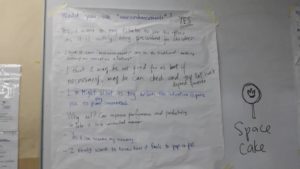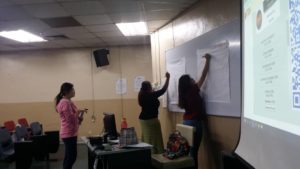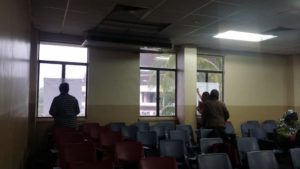I did round robin Gallery Walk activity in my class this semester. Alhamdulillah the students are ok with that.
Gallery Walk is meant to allow students to exchange ideas by taking turn to give their feedback/response/comment. It allows everyone to talk/write their thoughts. HERE is one example of Gallery Walk.
You can give them a reading material first before you start this activity or it can be based on what you have previously discussed and you want the students to summarise the points, if you are afraid that their “sharing” ideas might not be fruitful.
For me, with the undergraduates, I don’t give them a long reading material because they might need extra [long] time to finish reading. But with the PG students, I can finish the activity within 45 minutes [reading = 30 minutes, 15 minutes for them to “go round” the class to write their answers on the manjung paper]. Rather than grouping them into groups, I create a station where they can write their ideas.



How to conduct Gallery Walk activity?
Steps:
- Think about a topic that you want to discuss.
- Decide on the amount of questions or topics you would like to be discussed. In my case, I set 5 questions [plus muddiest concepts]
- Ideally, arrange the desks or tables so that discussion flows nicely and students can move about easily. But since I want the students to move around the class, I post the mahjung paper on the wall/white board instead. So, rather than sitting, they will walk around to different stations.
- Give each station [could be table, mahjung paper etc.] a question/topic. You can assign a leader to take note or in my case, I ask the students to take note of what others have written individually [individual accountability].
- Set a timer for each student to move around. There are other ways to do this. You can assign students to move in group or they can move individually to any station as they wish according to their preferences as long as they complete the round. If you have big classroom you can allow them to randomly move to different station, but if you have smaller classroom and large number of students, it is better to assign their movement from one station to another in orderly manner.
- Once every student has visited all the stations, you can ask one student to give a summary of one question/topic [based on the station] or if you select a leader (in this case, students are grouped at the beginning of the activity and their movement from one station to another in a group, rather than individually), ask the leader to give summary. In my case, we would discuss their responses based on station. There are 5 stations, so it takes me around 5-10 minutes to discuss on each question (station).
